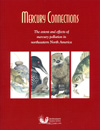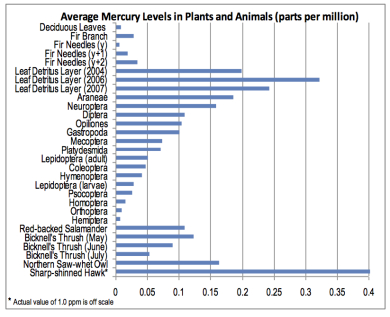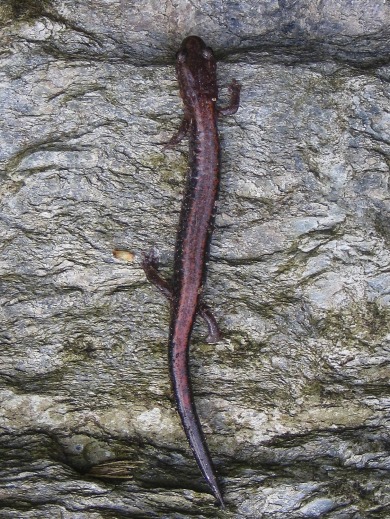Mercury is a pollutant that is cause for concern on local, regional, and global scales. Because mercury released into the atmosphere can circle the globe before being deposited, habitats located far from point sources can still be of major concern for wildlife health. The mountains in northeastern North America are one of those places.
MERCURY CONNECTIONS
From 2001-2005, our scientists were part of a landmark mercury research  partnership to compile mercury data from across the northeastern United States and Canada. As a result of that effort, 21 scientific papers were published in a special issue of the scientific journal Ecotoxicology and summarized in a report by Biodiversity Research Institute, Mercury Connections: The Extent and Effects of Mercury Pollution in Northeastern North America.
partnership to compile mercury data from across the northeastern United States and Canada. As a result of that effort, 21 scientific papers were published in a special issue of the scientific journal Ecotoxicology and summarized in a report by Biodiversity Research Institute, Mercury Connections: The Extent and Effects of Mercury Pollution in Northeastern North America.
KEY FINDINGS
Previously, most research had focused on mercury contamination in fish and fish-eating birds in aquatic environments. Our research found that montane forest songbirds had elevated mercury levels. Based on these findings, it is increasingly clear that mercury can no longer be viewed as strictly an aquatic pollutant. Conventional thinking held that mercury is limited to aquatic environments, since mercury is more readily converted to its toxic form (methylmercury) in water. Our data, reported in the Ecotoxicology volume, revealed that Bicknell’s Thrush and other songbirds were accumulating mercury, and nearly all of it in the toxic methyl form. This finding has implications for the way scientists and policy makers view the nature and extent of mercury in northeastern North America.
MERCURY BIOACCUMULATION AND TROPHIC TRANSFER IN THE MONTANE FOREST FOOD WEB
Offering novel insights into mercury’s threat to wildlife, our scientists for the first time revealed how this insidious toxin moves and concentrates across the food chain in forest ecosystems. In newly published research, VCE biologists tracked mercury up the food web – from tree needles and leaves to insects and spiders to salamanders and songbirds, and in due course to top predators such as hawks and owls. VCE’s work, published in the journal Ecotoxicology, is significant because it documents patterns of mercury’s migration through a forest ecosystem. The research could help inform the development of strategies to ease mercury’s dangerous effects on ecosystems and their wildlife inhabitants.
VCE biologists Chris Rimmer, Kent McFarland, and Steve Faccio, working as mercury
detectives on Vermont’s Stratton Mountain, tracked the toxin at discrete levels in the
mountain’s food web: leaf litter, foliage, foliage-eating insects, omnivorous arthropods (insects
and snails, for example), a terrestrial salamander (Red-backed Salamander), an insectivorous
songbird (Bicknell’s Thrush) and two raptors (Sharp-shinned Hawk and Northern Saw-whet
Owl). Their goal was to examine mercury concentrations and variability in organisms at
different trophic levels during summer.
KEY FINDINGS
 VCE’s work documented generally rising mercury concentrations up the food web — from plants to plant-eaters to carnivores. As might be expected, Sharp-shinned Hawk and Northern Saw-whet Owl, at the top of the montane forest food web, showed the highest mercury levels in their blood. Although leaf litter might be considered the base of the food web, this zone showed relatively high levels of mercury as well, higher than any other biotic compartment except Sharp-shinned Hawk. One explanation for this is that mercury can accumulate and persist over time in the leaf litter, leaching out of the fallen foliage during decomposition.
VCE’s work documented generally rising mercury concentrations up the food web — from plants to plant-eaters to carnivores. As might be expected, Sharp-shinned Hawk and Northern Saw-whet Owl, at the top of the montane forest food web, showed the highest mercury levels in their blood. Although leaf litter might be considered the base of the food web, this zone showed relatively high levels of mercury as well, higher than any other biotic compartment except Sharp-shinned Hawk. One explanation for this is that mercury can accumulate and persist over time in the leaf litter, leaching out of the fallen foliage during decomposition.
In live plant foliage, balsam fir needles showed greater concentrations of mercury than the three deciduous tree species VCE sampled: paper birch, mountain ash, and pin cherry. Fir needles grow and remain on a tree for up to three years, accumulating mercury each year, compared to only one-year’s growth in deciduous species. Even so, the three deciduous species showed increasing mercury levels throughout the season, at a rate higher than that observed in balsam fir needles
Moving up the food web to insects and other arthropods, mercury concentrations ranged widely but were lowest in herbivorous insects (such as grasshoppers, leafhoppers, and moth caterpillars), and higher in the predatory insects (such as scorpionflies and lacewings). Finally, among all arthropods sampled, carnivorous spiders and harvestmen showed the highest mercury concentrations, an expected result among these longer-lived predators of other insects.
Red-backed Salamanders showed relatively high concentrations of mercury, suggesting that they feed at higher trophic levels within the invertebrate community or that they prefer prey species that themselves accumulate relatively high amounts of mercury. As it turns out, Red-backed Salamanders live and forage in moist soils, often near stream edges, where methylmercury concentrations may be relatively high.
Perhaps the study’s most compelling discovery involved Bicknell’s Thrush. Mercury levels in this signature montane songbird spiked early in the season and decreased over the course of the summer. A likely explanation is that when Bicknell’s Thrush returns to breeding sites in May, spiders, harvestmen, predatory beetles, and other prey species relatively high in mercury are more numerous and probably constitute a significant portion of the songbird’s diet. Snails, also relatively high in mercury, may be consumed by female thrushes to mobilize additional calcium for egg production. But as new coniferous and deciduous foliage emerges during June, Bicknell’s Thrush almost certainly shifts its diet to newly abundant populations of leaf-eating insects with lower mercury levels. This seasonal dietary shift likely explains the decline in thrush blood mercury concentrations between early and late summer.
Results of VCE’s investigation provide critical evidence that mercury bioaccumulates and biomagnifies in the montane forest biotic community. Bicknell’s Thrush, already receiving ample attention from VCE, may serve as a valuable bioindicator for the continued monitoring of mercury contamination in terrestrial food webs. VCE’s previous work has already demonstrated that high-elevation coniferous forests are particularly vulnerable to climatic warming. The cumulative impacts of climate change, mercury toxicity and other stressors on these geographically restricted montane habitats could profoundly threaten their unique assemblage of flora and fauna, as well as aesthetic and recreational opportunities for millions of people in the northeastern United States.
SCIENTIFIC PUBLICATIONS
- Townsend, J.T., C.T. Driscoll, C.C. Rimmer, and K.P. McFarland. 2014. Avian, salamander, and forest floor mercury concentrations increase with elevation in a terrestrial ecosystem. Environmental Toxicology and Chemistry 33:208-215. (Abstract)
- Townsend, J.M., C.C. Rimmer, C.T. Driscoll, K.P. McFarland, and E.E. Iñigo-Elias. 2013. Mercury concentrations in tropical resident and migrant songbirds on Hispaniola. Ecotoxicology Volume 22 (1): 86-93. DOI 10.1007/s10646-012-1005-1. (Abstract)
- Rimmer, C.C., E.K. Miller, K.P. McFarland, R.J. Taylor, and S.D. Faccio. 2009. Mercury bioaccumulation and trophic transfer in the terrestrial food web of a montane forest. Ecotoxicology 19(4): 697-709. (Abstract)
- Rimmer, C.C., K. P. McFarland, D. C. Evers, E. K. Miller, Y. Aubry, D. Busby, and R. J. Taylor. 2005. Mercury levels in Bicknell’s thrush and other insectivorous passerine birds in montane forests of the northeastern United States and Canada. Ecotoxicology 14:223-240. (Abstract)

